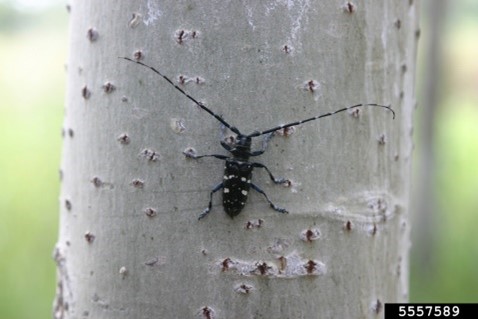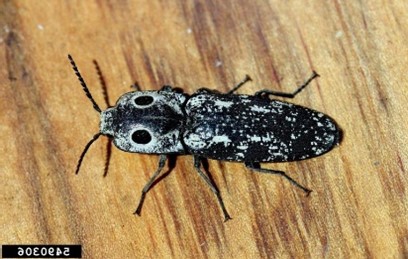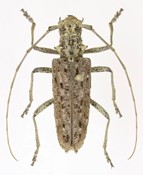
Balsam Woolly Adelgid (Adelges piceae)

Asian longhorned beetle (ALB) is a wood-boring insect that feeds on a wide variety of hardwood trees, such as maple, elm, birch and willow, eventually killing them. In the larval stage, this insect feeds on the nutrient rich tissues beneath the bark of tree, disrupting the flow of nutrients to the tree’s canopy, and into the heartwood of the tree, compromising the structural integrity of the wood. Multiple seasons of attack can lead to enough internal damage to cause branch dieback and tree mortality. The first signs of ALB can be observed about three years after infestation and tree mortality usually occurs within ten years.
Biology
Asian longhorned beetles (ALB) can infest many species of hardwood trees, including birch, ash, horse chestnut, sycamore and poplar, but preferring maple, elm and willow. Unlike other pest insects, ALB attacks both healthy and stressed trees.
Adult ALB are large black beetles (1-1.5 in. long) with small white spots and long black and white banded antennae. Female ALB adults lay eggs just under the bark of their host trees. Each female can lay up to 90 eggs in her lifetime. Eggs hatch in approximately two weeks and the small white larvae bore into the tree and feed on the living tissues that transport nutrients throughout the tree. Once the larvae have grown for several weeks, they begin to bore through the heartwood of the trees where they continue to feed and develop over the winter. Pupation lasts for up to 24 days then the adult beetles chew their way out of the tree, leaving a round exit hole approximately three-eighths of an in in diameter. Emerged adults feed on the bark and leaves of their host tree for 10 to 14 days before mating and laying eggs. Emergence occurs throughout the summer and fall because ALB can overwinter in multiple life stages. For more information about ALB visit the USDA APHIs ALB webpage.
Where it’s from
ALB is native to China and the Korean peninsula. It was first detected in the U.S. in Brooklyn, New York in 1996 and likely arrived in wood packing material from Asia.
How it spreads
Although adult ALB can fly for 400 yards in search of host trees, they usually remain on or near the tree they emerged from and are slow to spread at the beginning of an infestation. This makes early detection of new infestations critical in managing this pest. Since this is a wood boring insect, the larger threat of spread is the larval stage when the insects are contained within wood materials and are not visible. Larvae can infest a variety of items, including firewood, solid wood packing material, wood debris and trimmings, branches, logs, stumps and lumber. Infested items can be transported over long distances and begin new infestations.
Where it’s found
Since its initial detection in New York, ALB infestations have been discovered in Illinois, New Jersey, Massachusetts, Ohio and South Carolina. Fortunately, the populations in both Illinois and New Jersey have been fully eradicated. Infestations currently remain in New York, Massachusetts, Ohio and South Carolina, where regulations are in place and eradication efforts are underway.
What’s being done
Due to the extreme threat of ALB, strict regulations have been established at both the state and federal level. To prevent new ALB infestations from entering the U.S., all imported wood packing material is required to be heat treated or fumigated before being imported.
To stop the spread of current infestations, quarantines are established up to a 1.5-mile radius from infested trees that restrict the movement of regulated materials. Regulated materials include firewood, green lumber, nursery stock, logs, stumps, roots, branches and debris of half an inch in diameter or larger of any hardwood species known to be a viable ALB host. Areas within and near ALB infestations are surveyed regularly for signs of ALB and quarantine boundaries are updated if needed.
The USDA Forest Service and APHIS, and some state universities are conducting research focused on regulatory treatments for wood and nursery stock, traps and lures for adult ALB, using dogs to detect ALB presence, insecticide treatments for controlling ALB and various behavioral experiments.
Images of Asian Longhorned Beetle and its damage
Early/young ALB:


Damage:


ALB infested trees
Early damage:


Later damage:


Look alikes:






Is ALB near me?
Maps or links to maps noting areas of infestations:
The current distribution of ALB with latest detection dates and eradication information (map credit: USDA APHIS)
What can be done?
Management options for:
Homeowners –
Homeowners have and important role in detecting new infestations and preventing the spread of ALB. Early detection of this pest is crucial in eradiation. Anyone living within or near known infestations of ALB should conduct regular surveys of the hardwood trees on their property to look for signs of ALB. August is the best month to survey trees for ALB signs which include round exit holes about a quarter inch to the size of a dime, shallow oval or round scars in the bark where an egg has been laid, sawdust-like material on the branches or ground beneath the tree, dead limbs on an otherwise healthy-looking tree, or the beetle itself.
If signs are found, take photos and report them immediately. If you think you found the beetle, try to capture and freeze it, which will preserve it for identification, and report it immediately. All residents within established quarantine areas should adhere to all quarantine rules and refrain from moving regulated materials. Additionally, it is important for homeowners within or near infested areas to give program officials access to your property for them to conduct surveys, apply treatments and, if necessary, remove high-risk or infested trees.
Municipal –
The eradication of ALB in the U.S. relies heavily on the cooperation of all involved stakeholders. Municipalities play a large role in detecting new ALB infestations, as well as preventing the spread of existing infestations. Emergency pest response programs lead by state and federal agencies are essential in controlling ALB.
Working with local government to assess the threat of ALB and educate local businesses and the public, allows for a smooth and quick response to ALB. Municipalities or businesses within quarantined areas involved in handling or moving regulated host material, must attend compliance training workshops and enter into a compliance agreement with the ALB eradication program in their state. If materials are believed to be ALB-infested, the eradication program should be notified immediately. Due to tree removal being the most effective control measure, federal and state agencies offer tree replanting programs. Local governments may participate in these programs to replant nonhost trees and ensure diversity of tree species.
Federal/State response to ALB finds
When a new infestation of ALB is detected, USDA APHIS orchestrates eradication efforts working with federal and state officials. Initially, surveys are conducted to gather the extent of the infestation and establish quarantine boundaries. Investigations are conducted to determine the source of the infestation. Eradication methods are determined through an environmental assessment on a case-by-case basis.
Currently, there are two main methods to control and eradicate ALB. The priority when responding to a new ALB infestation, is removing infested host trees. Any tree that exhibits signs of ALB activity or damage must be removed and destroyed by chipping or incineration. It is recommended that the stump and roots of the trees also be removed to a minimum of six inches below ground level and destroyed. High risk host trees, or viable host trees that do not exhibit signs of ALB but are within one-half mile of infested trees, may also be removed due to the risk of infestation. Chemical treatment is the second control option utilized. Imidacloprid can be applied to high risk host trees in an effort to prevent infestation. Treatments can be made prior to and during adult emergence in the spring and early summer. To ensure that enough insecticide remains in the trees to kill ALB, applications should be repeated once yearly over a three year period. Imidacloprid treatments do not guarantee control of ALB because the chemical may not be distributed throughout the tree uniformly due to variability in treatments, weather conditions and tree health. Additionally, chemical treatment has shown to be ineffective against large larvae already present within a tree at the time of treatment.
At this time, a combination of enforcing quarantine restrictions, removing host tree species and performing chemical treatments provides the best management of ALB, but new methods of control and eradication may emerge from continued research.
Regulatory information
Regulations to prevent the spread of ALB are in place at both the federal and state level. Federal quarantines are in place to restrict the international and interstate movement of regulated host plant material. State quarantines control the intrastate movement of regulated host plant material. Any entity that handles or moves regulated material in interstate or intrastate commerce must obtain a compliance agreement to continue.
All host material leaving a regulated area without a permit must be chipped to a size of less than one inch in at least two dimensions. States with active quarantined areas are New York, Massachusetts, Ohio and South Carolina.
Who to contact
-
Michigan —
- MSU Plant & Pest Diagnostics: Email pestid@msu. edu or call 517-355-4536.
- Michigan Department of Agriculture and Rural Development: Email MDA-Info@michigan.gov or call the MDARD Customer Service Center, 800-292-939. Michigan Invasive Species -- ALB
- Midwest Invasive Species Information Network’s (MISIN): use the online reporting tool or download the MISIN smartphone app and report from your phone: http://www.misin.msu.edu/ tools/apps/#home
- State Plant Health Director: Craig Kellogg (USDA, APHIS, PPQ)
- Phone: (734) 942-9005
- FAX: (734) 942-7691
- Email: Craig.Kellogg@usda.gov
- Phone: (518) 402-9425
- Email: foresthealth@dec.ny.gov
- Phone: (866) 265-0301
- Phone: (518) 218-7510
- Phone: (508) 340-3785
- Email: felicia.hubacz@mass.gov
- Phone: (508) 852-8090
- Phone: (617) 565-7030
- Phone: (513) 381-7180
- Email: ALB@agri.ohio.gov
- Phone: (614) 322-4700
- Website: South Carolina ALB Report Form
- Phone: (843) 973-8329
- Phone: (843) 480-4334
USDA APHIS “Report It” webpage, or call 1-866-702-9938